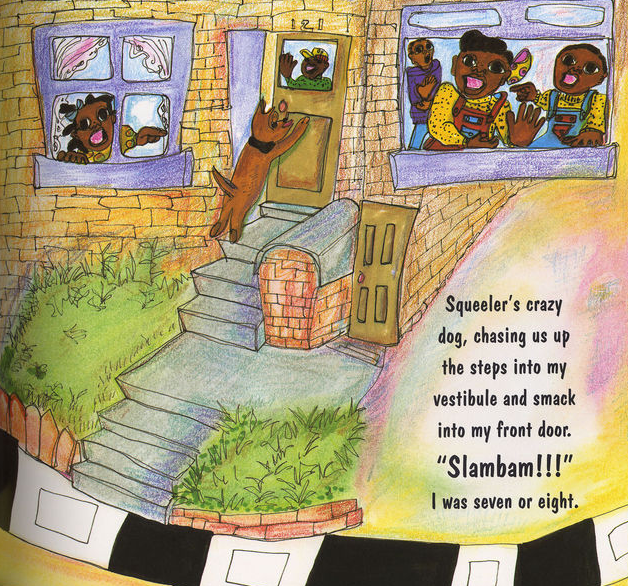HDEV00025
The book I have chosen to analyze is 'I Remember "121"', written and illustrated by Francine Haskins. The book was published in 1997 in San Francisco, and it tells a very autobiographical story of the author, Haskins, and her memories of the brick house she grew up in in Washington D.C in the 1950s. There isn't a very explicit plot to the story; each page is mostly just a different memory of Haskins', and all of them are generally pleasant. For example, Haskins recounts the time her little brother was born, and the times when her mother would take the children to Baltimore for a day trip. The book is very simple, and most of its story is told through its illustrations with the support of the text.
The most important feature of the book is the fact that it is about an African American girl and her extended family. There is no depiction of any person of color aside from black, not with people on the street or any of Haskins' school friends. I don't think this can be viewed as a criticism in this case, because this is a situation that's probably very realistic from the author's perspective, and the book is autobiographical. I think the book is mostly very innocent and straightforward, and it doesn't have any real moral lesson to offer, though I sensed a definite implication that the author wanted her reader to notice her community. The book is all about the girl, growing up with a huge family, a lot of neighborhood support, in what appears to be a very healthy and loving environment. It shows the reader that Haskins had a beautifully close-knit group family and friends, one that she was proud enough to write a book about. The fact that this group was entirely (or mostly) black is both important and incidental.
On my first read-through, I felt a little uncertain regarding the way one stereotype was presented. There's a page in the story where Haskins' depicts her aunt cooking family dinner, which consisted of fried chicken, collard greens, and corn - foods now very stereotypically associated with African Americans. I was rather worried by this one page and it set me up to keep a look-out for other stereotypes that might be in the book. However, when I read through it a second and third time, I realized that this one page wasn't a stereotype as much as it was an actual, valid part of the author's life. The book has really lead me to question what grounds an assumed stereotype has when it's told from the perspective of someone who genuinely experienced it at one point in their life, as is the case here with Haskins. I don't think it's always right to quickly judge right and wrong when faced with stereotypes, like I initially did here. Sometimes they can be very important and sentimental parts of a person's life, in which case they deserve to be met with respect.
In general, I don't believe the depiction of Haskins and her family is a stereotypical one. It's authentic and perhaps familiar, but it doesn't carry any negative or pitiful subtexts that might exist in other stories from the time and place that "121" is set. How is 1950's DC usually shown to people through media? There are always issues with civil rights, violence, racism and poverty when looked at from an African American perspective (a well-known film that depicts this, for example, is the recent movie 'The Butler', and it's just one example out of many). "121" is completely divorced from this, and it breaks the stereotype that that difficult sort of life is all that African Americans ever knew at that period in time. Haskins' mother is a teacher who values intellect and cultural learning. Her father is fun and gentle with his children, and teaches them about the joy of laughter. Her neighborhood is safe and everyone looks out for one another. Overall, the book shows a great facet of African American culture, one that's too often overlooked in favor of more dramatic material.
I would absolutely recommend "121" and would be happy to see it on any classroom bookshelf. The book offers a lot of lessons for children, but it's told in a sweet and laid-back way. I can easily imagine a teacher reading this to her class and then provoking some really good questions afterwards from the children. It has a lot to do with race, class, culture, and the like, and the book offers a point-of-view of a family that many kids may or may not be familiar with; the detail the Haskins' family is depicted with is very illustrative, though, and would give children a good understanding of the story and its characters even though they might not be able to relate directly. The story depicts a black, middle-class, large and close-knit family with happiness and warmth. The fact that it's a story actually written by a person from that group makes it all the more genuine and rich.
The author with one of her books.
Resources
Haskins, F. (1997) I Remember "121". Retrieved from childrenslibrary.org



